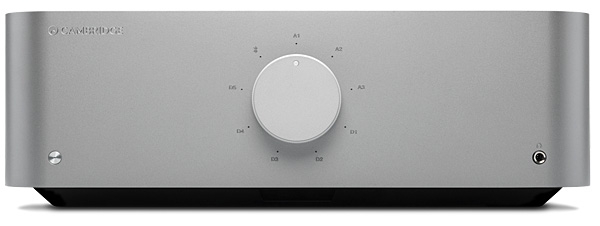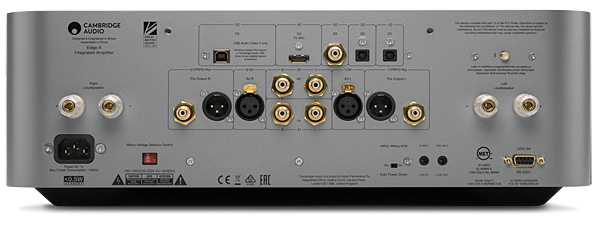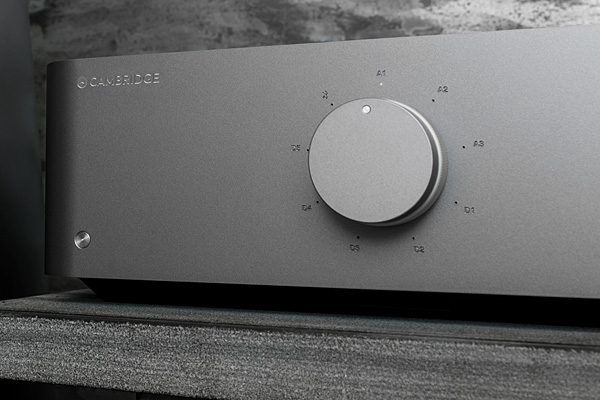| Columns Retired Columns & Blogs |
May be KM or HR or JA could keep this Cambridge Edge A around for a while and review some of the 'affordable' loudspeakers under $5,000 or even under $10,000 :-) ............

Cambridge Audio—founded in 1968 and now based in London, with manufacturing facilities in China—is perhaps best known for its budget products. But in 2015, owner James Johnson-Flint, managing director Stuart George, and technical director Dominic Baker challenged their 20-strong design team to create three state-of-the-art components in time for the company's 50th anniversary. Thus did Cambridge Audio develop their Edge series: the Edge NQ preamplifier and network player ($4000), the Edge W power amplifier ($3000), and the subject of this review, the Edge A integrated amplifier ($5000). Both amplifiers output 100Wpc into 8 ohms or 200Wpc into 4 ohms.
Via e-mail, Baker had this to say about the Edges:
"[The Edge line] is by no means a sudden leap into high-end. The CD1 two-box CD player was the first of its kind having the transport and DAC separated. It was the most expensive CD player in the world at the time [footnote 1]. At Cambridge Audio we adapt to the market and our customers, and for our 50th anniversary we felt that the time was right for Edge. Whilst in terms of performance, we're delighted that Edge is being talked about in the same breath as other product costing more, we wouldn't necessarily refer to it as 'ultra high-end'—it still lives up to our core brand promise of offering exceptional value."
Design
Named for Cambridge Audio's first principal designer, Prof. Gordon Edge—he later founded the influential Cambridge Technology Centre—the Edge components have a singular look: matte-finished, dark silver cases with a boldly minimalist user interface. On the basis of comeliness alone, the Edge components punch way above their price point(s).
The Edge A measures 15.9" wide by 5.9" high by 18.1" deep. Dominic Baker described its case to me: "Front panel, rear panel, and heatsinks are all aluminum. Bottom and top plates are powder-coated steel." Feeling solid and massive at 53.7 lb, the Edge A is extremely well built, formidable of feel, and subtle in visual design. It's handsome, smartly executed, and should blend well with any décor, from my IKEA-furnished Greenwich Village lair to a toney Upper East Side townhouse. The rounded corners of the Edge A's case conceal the large heatsinks that comprise the side panels.

Other than a phono input, the Edge A dings all the bells and blows all the whistles a modern integrated amplifier should, including: S/PDIF digital inputs, Bluetooth aptX HD, which enables streaming audio up to 24-bit/48kHz; USB Audio Class 2.0, which supports up to 32/384 PCM and DSD256; a headphone jack; and a preamplifier output.
There's some clever technology inside. The Edge A is specified to output 100Wpc into 8 ohms or 200Wpc into 4 ohms, running in what Cambridge calls Class XA, which reportedly "shifts the crossover point out of audible range." In addition to creating the shortest signal paths possible and entirely eliminating capacitors, the Edge A uses "opposing symmetry twin toroidal transformers" that "cancel out stray electromagnetic interference." How is the latter achieved? Baker explained:
"It's the same principle as acoustic engineers used to use in the past to avoid centre speakers interfering with your CRT TV. A second magnet would be added to the rear of the pole piece in reverse orientation to the main magnet to cancel out stray fields. A toroidal transformer is an electromagnet rather than a passive ferrite magnet, but a magnet all the same. So the principle applies itself in the same way. We also apply a silicon steel screen tape around each transformer to reduce stray fields, then any that is left is cancelled out by the opposing arrangement. The result is that far less electromagnetic radiation interferes with the sensitive input stage of the amplifier. The effect works at all volume levels because each transformer is delivering the same current, so they are in harmony[,] cancelling out each other's electromagnetic field throughout the whole power range."
Part of Cambridge's Class XA technology involves adding a bias voltage to a traditional class-AB design, which they claim results in "less heat." But I found that the Edge A ran slightly hot to the touch. What gives? Baker again:
"It runs hotter than a class-AB amplifier because of the bias position, rather than the bias level. Class XA shifts the bias position away from the zero crossing point, where effectively there is no signal level and any distortion can be heard/measured, to a point in the waveform where there is a higher signal level and any distortion is effectively masked. It's less efficient than a class-AB amplifier, but more efficient than a class-A amplifier, but with the same sound quality benefits."

Continuing the novel electromechanical approach used in the Edge models, in the Edge A Cambridge has replaced capacitors with DC-coupled technology. Baker explained:
"Capacitors . . . have the biggest detrimental impact on . . . sound because they have wide tolerances and are basically made from a wound metal foil with a dielectric in-between. This makes them susceptible to microphony. Removing them results in a cleaner signal path that is less susceptible to distortion. We use servos [to] inject an equal and opposite amount of DC into the signal to cancel out any DC offset, rather than using capacitor[s] to block it."
Description
The Edge A arrived secured within a form-fitting Styrofoam platform inside the inner of two boxes of thick cardboard, themselves heatshrunk-sealed to a single massive shipping pallet. I extracted the amp from all this, unzipped it from its black-velvet cocoon, and strong-armed it into my Salamander rack.

May be KM or HR or JA could keep this Cambridge Edge A around for a while and review some of the 'affordable' loudspeakers under $5,000 or even under $10,000 :-) ............

Welcome to 21st century :-) ...........

The headphone output impedance of 10 ohms is not low. It's high enough to interfere with the sound quality of efficient headphones. By way of example, the Schiit Magni 3 headphone amp has an output impedance of 0.6 ohms.

Agreed ........ All the portable Chord self-powered head-amp/DACs like Mojo, Hugo2 and Hugo TT2 have headphone output impedance less than 1 Ohm .......... Rogue RH-5 (Stereophile Class-A) has head-amp output impedance between 1-3 Ohms .......... 10 Ohm output impedance can drive top of the line Sennheiser and Focal headphones and some others with high impedance :-) ............

"The CD1 two-box CD player ... was the most expensive CD player in the world at the time." - sounds like misinformation, to say the least.

https://www.whathifi.com/features/best-24-cd-players-what-hi-fis-lifetime
"[In 1986] Cambridge Audio's CD1 cost a fortune at £1500. Double, if not triple, most other players."

Technics SL-P50P - 1984 - $4000. I'm pretty sure there's more examples.

An amp that turns itself off after a few seconds with a fault doesn't sound like fun to me. Especially not at this price point.
Last time Stereophile tested a flagship CA integrated (the 851), the first sample broke and the second was faulty. This time the first one broke.
On this evidence, isn't JA being generous with his assumption that the shipper was at fault? Seems like a bit of a trend is developing, slightly worrying on what are not cheap items.
Personally, at this price I'd be looking at items manufactured in-house, not outsourced to China.
Thanks for a great magazine, by the way.

What did you expect? It's MADE IN CHINA.

....demand that any hi-fi (possibly any electronic device) unit running a negligible signal for more than 20 minutes must power down. And it's easily defeat-able; I was only making note that it's bothersome.
Beyond the issues that greeted JA after I had the CA in house, build quality was excellent, the unit worked perfectly, and sounded fantastic, never mind where it was manufactured.

"A few seconds after I first powered up Ken Micallef's review sample of the Edge A..... it turned itself off, its front-panel light glowing red to indicate a fault" says JA.
What's that got to do with "Brit" regulations, and how is it defeatable?
And build quality was excellent, the unit worked perfectly, and it broke and had to be replaced.
Gotcha!

May be you (KM) could review one of the ATC self-powered active loudspeakers, preferably with the ATC CD player/pre-amp, you recently reviewed? :-) ..........

Ken mentioned this is the best integrated that he's auditioned. And I see that is not a small number in the past few years. Is this piece really more impressive than the Luxman? I ask because I'm demoing it right now. My old Krell KAV300i is getting long in the tooth and I was looking for something a bit more refined. IMO, this is a really nice piece; well defined sound and easy to listen to for long periods.